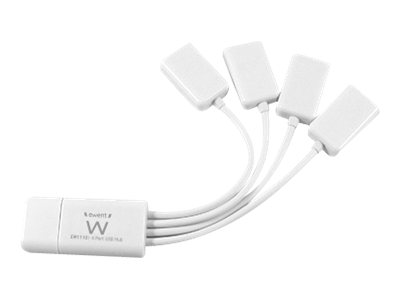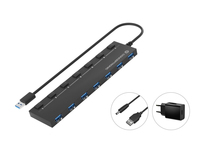USB Hubs: More Ports, More Flexibility for Your Digital Devices
Modern laptops, PCs, and even tablets are becoming increasingly compact and slim, often resulting in a reduced number of available USB ports. USB hubs are the clever and often indispensable solution to elegantly overcome this limitation. They expand a single USB port on your computer (or other host device) into multiple full-featured ports, enabling the simultaneous operation of a multitude of peripheral devices such as mice, keyboards, external hard drives, USB flash drives, webcams, printers, and more. Whether for a tidy desk in the office, a flexible home office, creative workflows, or mobile use on the go – a USB hub boosts your productivity, connectivity, and organization. Discover the diverse world of USB hubs at etree and find the right model to get the most out of your devices and avoid port shortages.
From simple port multipliers to multifunctional adapters with video outputs and network connections – USB hubs are true all-rounders.
Why a USB Hub? The Convincing Advantages in Detail:
- Massive Expansion of USB Ports: Turn a single USB port into three, four, seven, or even more ports and connect all your devices simultaneously.
- Simultaneous Connection of Multiple Peripherals: No more need to constantly swap devices. Mouse, keyboard, external hard drive, USB stick, and webcam can remain connected in parallel.
- Improved Organization and Less Cable Clutter: Centralize the connection of your USB devices in one place, leading to a tidier and more organized workspace.
- Options with Own Power Supply (Powered Hubs) for Stable Performance: Reliably power power-hungry devices and prevent performance issues or connection drops.
- Charging Functions for Smartphones and Other Devices: Many powered hubs or hubs with special charging ports can charge mobile devices quickly and efficiently.
- Models with Useful Additional Functions (Multiport Adapters): Some USB hubs, especially USB-C hubs, integrate additional interfaces such as Gigabit Ethernet, SD/microSD card readers, HDMI/DisplayPort video outputs, or audio jacks, thus functioning as mini-docking stations.
- Portability for On-the-Go: Compact and lightweight USB hubs are ideal companions for laptops, ensuring you don't have to forgo important ports when traveling or giving presentations.
- Cost-Effective Solution: Compared to full-fledged docking stations, USB hubs are often a significantly more affordable way to increase port variety.
The World of USB Hubs in Detail: Types, Standards, and Technologies
USB hubs come in various designs, differing by USB standard, power supply, and feature set:
USB Standards and Speeds – From Basic to High-Speed:
- USB 2.0 (HighSpeed): Offers data rates of up to 480 Mbps. Sufficient for basic peripherals like mice, keyboards, or simple printers. Less common in new hubs today, except for very budget-friendly models.
- USB 3.x (SuperSpeed/SuperSpeed+): Includes standards like USB 3.0 / 3.1 Gen 1 / 3.2 Gen 1 (up to 5 Gbps), USB 3.1 Gen 2 / 3.2 Gen 2 (up to 10 Gbps), and USB 3.2 Gen 2x2 (up to 20 Gbps). Ideal for fast data transfers with external SSDs, high-resolution webcams, and other bandwidth-intensive devices. Ports are often marked blue or turquoise.
- USB-C as a Connector and Standard: USB-C is not only a reversible connector type but can also support various USB standards (up to USB4 and Thunderbolt™ on compatible devices/hubs) as well as alternate modes like DisplayPort Alt Mode (for video) and Power Delivery (for power). USB-C hubs are therefore often particularly versatile.
Powered (Active) vs. Bus-Powered (Passive) Hubs – The Power Supply Question:
- Bus-Powered USB Hubs (passive): Draw their power directly from the USB port of the host device (e.g., laptop). They are more compact and portable as no external power adapter is needed. However, the total available power is limited, which can lead to problems if multiple power-hungry devices are connected.
- Powered USB Hubs (active): Have their own external power adapter and can therefore supply significantly more power to connected devices. They are the better choice for connecting external hard drives (especially 3.5-inch HDDs), multiple peripherals simultaneously, or devices with higher energy requirements. Many powered hubs also offer dedicated charging ports.
USB Hubs with Specific Additional Functions (often referred to as Multiport Adapters):
Especially modern USB-C hubs are often true all-rounders:
- With Ethernet Port (RJ45): Integrate a Gigabit Ethernet port for a fast and stable wired network connection – ideal for laptops without their own LAN port.
- With Integrated Card Readers: Allow direct reading of SD and/or microSD memory cards from cameras, smartphones, etc.
- With Video Outputs (HDMI, DisplayPort, VGA): Enable the connection of one or more external monitors. This requires the USB-C port of the host device to support DisplayPort Alternate Mode.
- With Audio Jack (3.5mm): Provide a connection for headphones, headsets, or external speakers.
Key Technologies and Features of USB Hubs:
USB Power Delivery (PD) – Laptop Charging and Flexible Power Supply
Many USB-C hubs support USB Power Delivery. This means the hub can not only power devices but also charge the connected notebook itself if the hub, in turn, is connected to a powerful USB-C power adapter (often the laptop's power adapter, which is passed through the hub – "PD Pass-Through"). The maximum charging power (in Watts) is an important criterion here.
DisplayPort Alternate Mode (DP Alt Mode) over USB-C for Video Transmission
For a USB-C hub to use video outputs (HDMI, DisplayPort), the USB-C port of the host device (laptop, tablet) must support DisplayPort Alternate Mode. This mode allows the transmission of native DisplayPort signals via the USB-C interface.
USB Battery Charging (BC 1.2) for Optimized Charging
Some USB-A ports on powered hubs may support the BC 1.2 standard, which allows mobile devices to be charged with higher current (up to 1.5A) than a standard USB data port.
Individual Port Switches and Status LEDs
Some hubs offer individual on/off switches for each USB port and a status LED. This can be useful for powering off unused devices to save energy or to check the function of individual ports.
Which USB Hub for Which Use? – Application Examples:
- Expanding ports on modern ultrabooks and MacBooks that often have only a few USB-C ports (USB-C multiport adapters).
- Creating a central connection point on the desk for mouse, keyboard, printer, external hard drive, and USB flash drives (desktop USB 3.x hub, ideally powered).
- Quickly charging smartphones and tablets параллельно to data use (powered hub with dedicated charging ports or USB PD).
- Use as a compact mini-docking station for laptops when video output, Ethernet, and additional USB ports are needed (USB-C hub with HDMI/DP and LAN).
- Temporary expansion of USB ports during presentations or travel (compact, bus-powered hub or travel multiport adapter).
- Connecting older USB peripherals to new computers with exclusively USB-C ports (USB-C hub with multiple USB-A ports).
What to Look for When Buying a USB Hub? A Checklist:
- Number and Type of Required USB Output Ports: How many devices with which USB type (USB-A, USB-C) need to be connected simultaneously? Which USB version (2.0 for simple peripherals, 3.x for fast data transfer) is needed for these ports?
- Hub Power Supply: Is a Bus-Powered (passive) hub sufficient for your needs (primarily for low-power devices and portability), or is a Powered (active) hub with an external power adapter the better choice for power-hungry devices or stable supply to many devices?
- Required Additional Functions/Ports: Is an integrated Gigabit Ethernet port, an SD/microSD card reader, video outputs (HDMI, DisplayPort, VGA), or an audio jack needed?
- Compatibility with the Host Device: PC, Mac, laptop? USB-A or USB-C port on the host? Does your laptop's USB-C port support DisplayPort Alternate Mode (for video) and Power Delivery (for charging the laptop via the hub)?
- USB Power Delivery (PD) via the Hub (for USB-C Hubs): If your laptop is to be charged via the hub, check the maximum pass-through power (in Watts) of the hub and whether it is sufficient for your laptop model.
- Video Output Specifications (for hubs with video ports): What resolutions (e.g., Full HD, 4K) and refresh rates (Hz) are supported with how many connected monitors?
- Cable Length of the Hub's Connection Cable: Is the fixed or supplied connection cable of the hub long enough for the planned placement?
- Portability and Design: Will the hub be primarily used stationary, or should it be as compact and lightweight as possible for travel? What material (plastic, aluminum) is preferred?
- Brand, Quality, and Reviews: Pay attention to products from established manufacturers and read user reviews regarding reliability and performance.
- Budget: Prices for USB hubs vary greatly depending on the number of ports, USB standard, power supply, and additional functions.
At etree, you will find a diverse selection of USB hubs for every need. Our detailed product information will help you find the perfect hub for your devices and use cases.









